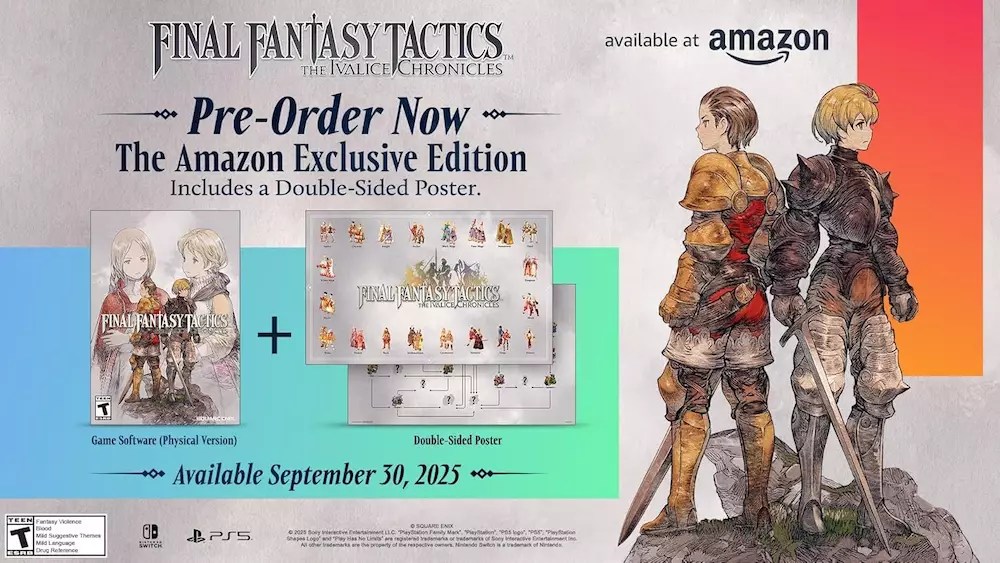Final Fantasy Tactics: The Ivalice Chronicles isn’t just a remaster; it’s an essential renaissance of a beloved tactical masterpiece, and Square Enix’s approach exemplifies a keen understanding of how to honor legacy while embracing technological progress. The decision to deliver a free Nintendo Switch 2 upgrade alongside the original game underscores a strategic move to incentivize players to stay loyal across platforms, especially in a market that’s increasingly moving toward digital dominance. The absence of a physical edition for Switch 2 might initially seem like a missed opportunity, but this move cleverly pushes fans toward digital upgrades and preorders, ensuring a seamless transition with enhanced visuals and performance.
The upgrade pack’s pre-order availability on the eShop demonstrates a bold, consumer-focused strategy: offer immediate value with no extra cost while nudging players towards the latest hardware. This tactic capitalizes on the audience’s nostalgic attachment and their desire for the best experience, while Square Enix subtly encourages a console generational shift. Such strategies speak volumes about the current gaming landscape—physical editions are still cherished, but digital upgrades are becoming the new gold standard for flow, accessibility, and cost-efficiency.
Scarcity and Collectibility: The Power of Limited-Edition Features
Beyond the core game, Square Enix realizes that the collector market is potent—and it’s tapping into this with exclusive merchandise and limited editions. The Amazon-exclusive version, complete with a double-sided poster depicting character art and class flowcharts, exemplifies the blending of visual artistry and strategic gameplay. These items add a layer of tangibility and prestige that digital copies simply cannot replicate. Since these bonuses are technically part of the main product, their scarcity can significantly impact purchasing urgency—once sold out, these items could become highly sought after relics among collectors.
Meanwhile, the more luxurious Square Enix Store-exclusive Collector’s Box, priced at a hefty $200, encapsulates the company’s drive to turn game editions into collector’s artifacts. The inclusion of exclusive figurines, plushies, diorama displays, and art prints transforms the game into a keepsake, elevating it from mere entertainment to a treasured piece of memorabilia. Such strategic bundling elevates the game’s perceived value, appealing to dedicated fans willing to invest heavily in their passion. It’s a smart move—by emphasizing limited availability and exclusive content, Square Enix stokes the fervor and emotional attachment of its loyal audience.
Design Philosophy: Balancing Nostalgia and Modern Expectations
The revamped game’s visual and performance upgrade isn’t merely cosmetic; it’s an acknowledgment that players’ expectations for quality have evolved while respecting the game’s artful core. By offering a free Switch 2 upgrade, Square Enix demonstrates a commitment to improving the experience without alienating longtime fans who may prefer the physical edition. But it also raises questions about how physical editions are becoming secondary in the current market landscape, signaling a shift in how game publishers value tangible collectibles versus digital convenience.
The merchandise itself—ramza figures, plush chocobos, and intricate dioramas—clings to the nostalgic heart of old-school JRPG fans, while the high-quality production signals current expectations for premium collectibles. This delicate balance between honoring the past and adapting to future demands is the core challenge of modern game publishing. It underscores an insight that successful franchises now need to be more than just games—they must be comprehensive brand experiences that include art, merchandise, and digital enhancements to truly resonate.
Market Strategy and Consumer Dynamics
Square Enix’s selective inclusion of physical editions for Nintendo Switch and PS5, but not for Xbox or PC, reflects a nuanced understanding of market segmentation. The belief that physical collector’s editions and deluxe bundles are more viable and desirable within console ecosystems shaped their release strategy. This approach aligns with the fact that gaming enthusiasts on Nintendo and PlayStation platforms often prioritize tangible collectibles and premium packaging, viewing them as investments in their gaming identity.
Furthermore, the choice of a staggered release, with bonuses available only through certain vendors like Amazon, amplifies perceived scarcity—driving preorders and early adoption. The potential sellout of limited edition items emphasizes a deliberate scarcity tactic that bolsters demand and cultivates a sense of exclusivity. The move discourages passive purchasing and encourages early commitment, which benefits both the publisher and the retailer by guaranteeing early revenue streams and enthusiastic customer engagement.
An Evolving Landscape: Digital vs. Physical
The debate between digital convenience and physical collectibility has reached a tipping point, and Square Enix’s approach to Final Fantasy Tactics exemplifies how publishers might leverage both. The physical edition, with its extensive merchandise and special packaging, maintains a tangible appeal and creates a legacy product, while the digital version ensures accessibility and instant gameplay.
Yet, the transfer of upgrades and bonuses exclusively into digital realms raises concerns. It subtly discourages players who prefer physical copies from experiencing the full capabilities of their hardware, especially on the next-generation Switch. This dichotomy signals that the industry is leaning more toward valuing platform-specific upgrades, digital market dominance, and virtually limitless content, sometimes at the expense of traditional physical collector’s items.
Ultimately, the release strategy for Final Fantasy Tactics: The Ivalice Chronicles reveals not just a celebration of a gaming classic but a reflection of the shifting priorities of game publishers in a rapidly changing environment. Nostalgia remains powerful, but it’s increasingly being channeled into multimodal experiences—merchandise, digital enhancements, and limited editions—that ensure franchises stay relevant and profitable amidst technological advancement.


Leave a Reply